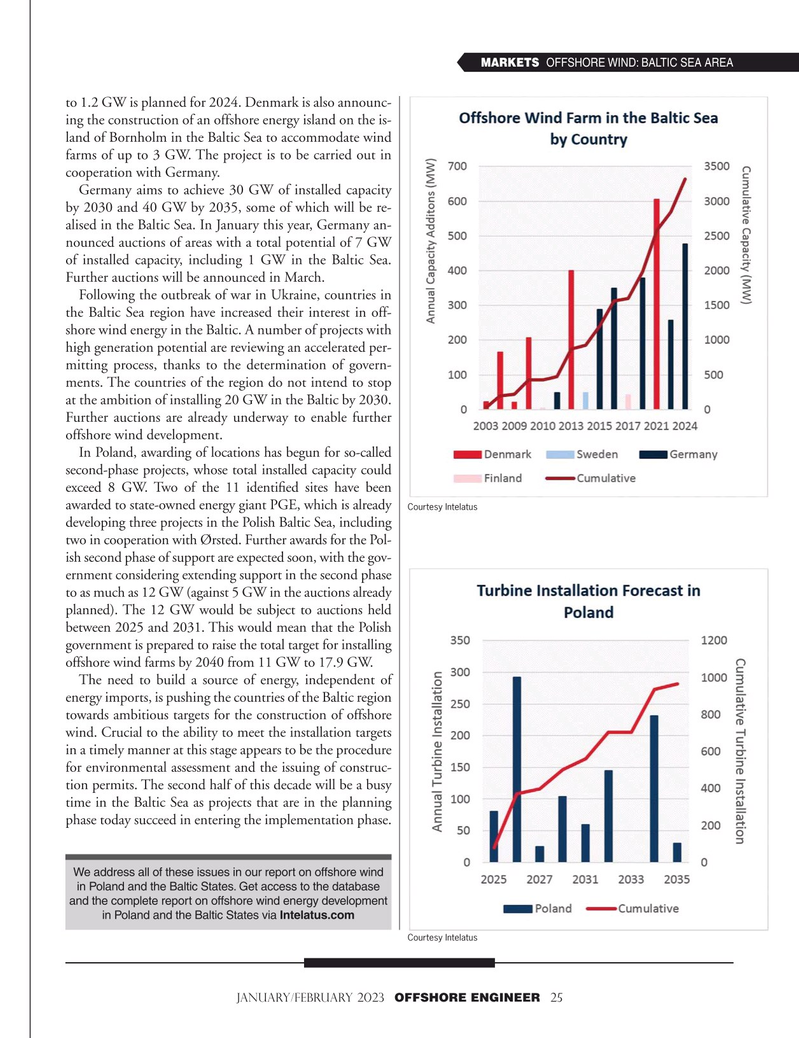
Page 25: of Offshore Engineer Magazine (Jan/Feb 2023)
Read this page in Pdf, Flash or Html5 edition of Jan/Feb 2023 Offshore Engineer Magazine
MARKETS OFFSHORE WIND: BALTIC SEA AREA to 1.2 GW is planned for 2024. Denmark is also announc- ing the construction of an offshore energy island on the is- land of Bornholm in the Baltic Sea to accommodate wind farms of up to 3 GW. The project is to be carried out in cooperation with Germany.
Germany aims to achieve 30 GW of installed capacity by 2030 and 40 GW by 2035, some of which will be re- alised in the Baltic Sea. In January this year, Germany an- nounced auctions of areas with a total potential of 7 GW of installed capacity, including 1 GW in the Baltic Sea.
Further auctions will be announced in March.
Following the outbreak of war in Ukraine, countries in the Baltic Sea region have increased their interest in off- shore wind energy in the Baltic. A number of projects with high generation potential are reviewing an accelerated per- mitting process, thanks to the determination of govern- ments. The countries of the region do not intend to stop at the ambition of installing 20 GW in the Baltic by 2030.
Further auctions are already underway to enable further offshore wind development.
In Poland, awarding of locations has begun for so-called second-phase projects, whose total installed capacity could exceed 8 GW. Two of the 11 identi?ed sites have been awarded to state-owned energy giant PGE, which is already
Courtesy Intelatus developing three projects in the Polish Baltic Sea, including two in cooperation with Ørsted. Further awards for the Pol- ish second phase of support are expected soon, with the gov- ernment considering extending support in the second phase to as much as 12 GW (against 5 GW in the auctions already planned). The 12 GW would be subject to auctions held between 2025 and 2031. This would mean that the Polish government is prepared to raise the total target for installing offshore wind farms by 2040 from 11 GW to 17.9 GW.
The need to build a source of energy, independent of energy imports, is pushing the countries of the Baltic region towards ambitious targets for the construction of offshore wind. Crucial to the ability to meet the installation targets in a timely manner at this stage appears to be the procedure for environmental assessment and the issuing of construc- tion permits. The second half of this decade will be a busy time in the Baltic Sea as projects that are in the planning phase today succeed in entering the implementation phase.
We address all of these issues in our report on offshore wind in Poland and the Baltic States. Get access to the database and the complete report on offshore wind energy development in Poland and the Baltic States via Intelatus.com
Courtesy Intelatus january/february 2023 OFFSHORE ENGINEER 25

 24
24

 26
26